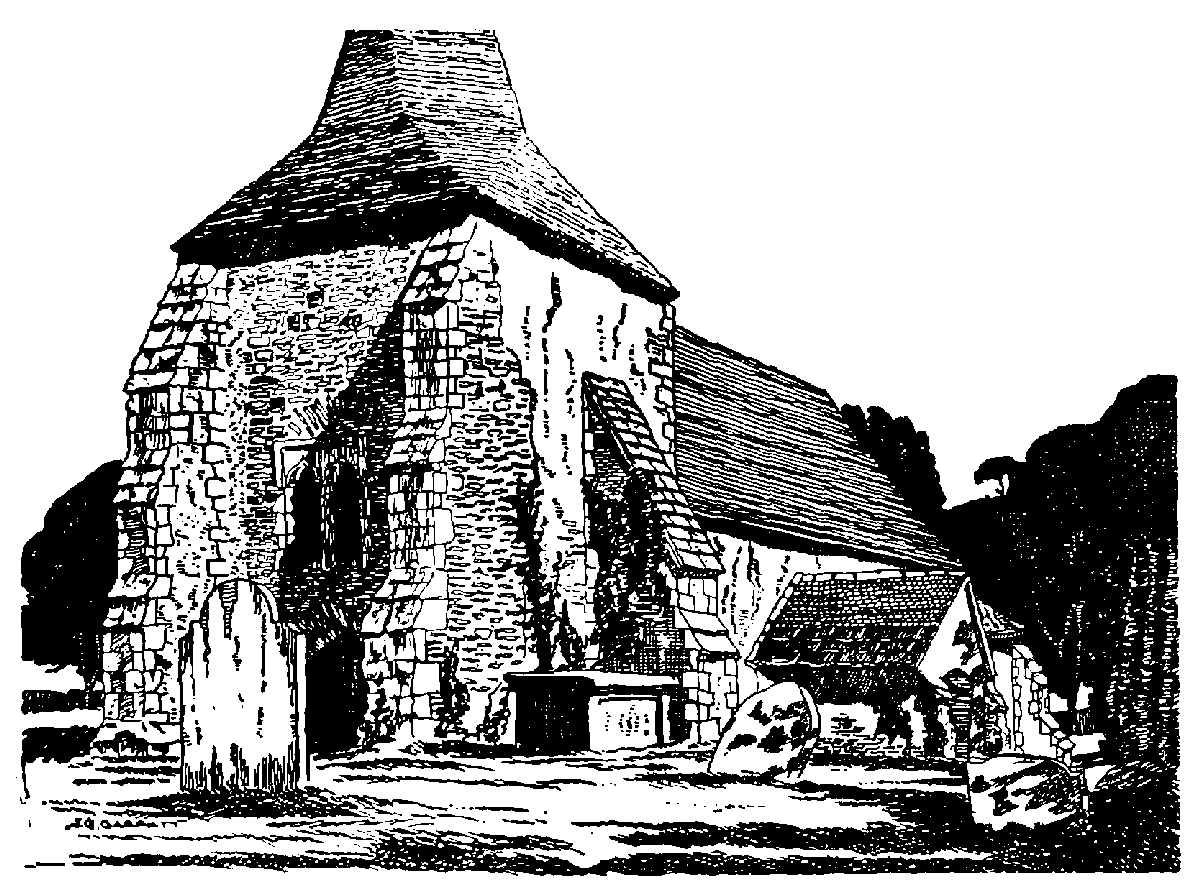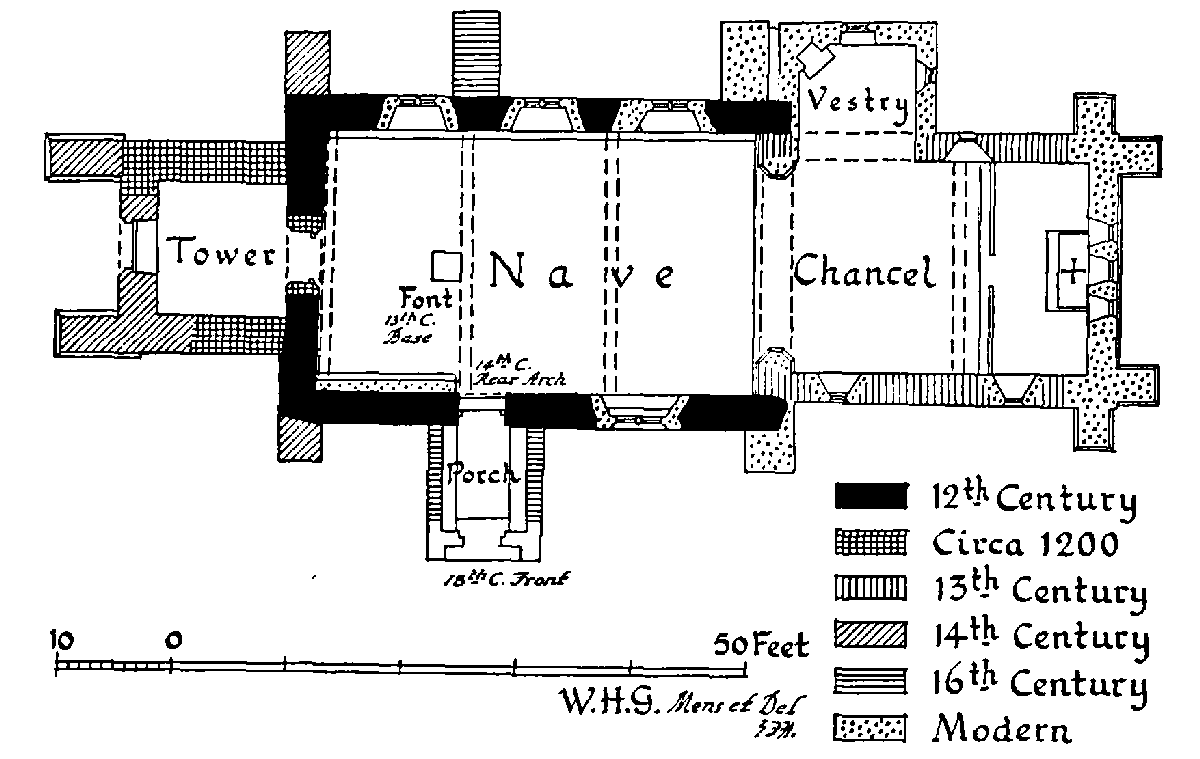



St Michael
Introduction
The Parish Church of St Michael and All Angels is grade I listed and is located within the grounds of Plumpton College. The nave was built c1100 and the west tower c1200 which was then altered in c1400. The chancel was rebuilt in c1300 and the south porch dated c1600 or c1700, was restored in 1866-7. The interior includes c1200 wall paintings, a c1300 wooden bell frame and a crown post roof to the nave.
History
The church is of unknown dedication but traditionally associated with St Michael. A church at Plumpton is mentioned in Domesday Book (12,42) but the nave of the existing church is of c1100 or slightly later. At the time of the Norman Conquest the right to appoint the rector was held by the church at Bosham but passed then, together with the manor, to William de Warenne. The church at Plumpton was granted by Rainald de Warenne to the Priory of St Mary Southwark in the c1200. By 1275 the Prior released it to William Bardolf of Plumpton Manor and it remained with the manor for 300 years, passing to the Beaumonts and then by grant of Henry VIII to Sr Nicholas Carew, whose son Francis sold both manor and advowson to Richard Leache in 1593. It passed to his widow, Charity, who married the Earl of Nottingham. In 1635 the advowson was conveyed by the Earl of Nottingham to William Hampton, the rector, and remained in this family until it was sold to the Woodward family between 1771 and 1786. The Woodwards retained it until 1931 when it was conveyed to the Bishop of Chichester.
Church
Plumpton Church
Details
Parish church. Nave of c.1100 or slightly later, tower of c.1200 altered in the C14, chancel rebuilt in the C13 and south porch of C16 or C17 date. The church was restored in 1866-7 by an architect not at present known, including nave windows in C14 style, rebuilding of the east wall, boarding of the nave roof and the replacement of the chancel arch. A vestry and organ chamber were added in 1886. In 1929 J L Denman restored the roof and porch and he repaired the chancel arch in 1932.
MATERIALS: flint walls with some Sussex marble, especially to the south side of the tower, with sandstone dressings but brick porch. The roofs are tiled except for some Horsham stone slabs to the lower part of the north side of the nave and the south porch and the spire roof, which is shingled.
PLAN: three-bay nave with lower two-bay chancel, west tower of two stages, south porch and north-east vestry.
EXTERIOR: the west tower is of two stages with a broached shingled spire. The west wall has a C14 window of two ogee-headed trefoiled lights with a chamfered label over a late C14 equilateral-arched doorway with wide chamfered head and jamb and a segmental rere-arch. There are C14 angled buttresses of three chamfered stages on a plinth. The north wall has a small c.1200 round-headed window in the upper or bell stage. There are no openings in the south wall of the tower. The nave south wall has no window openings. A buttress in line with the chancel arch has restored quoins incorporating two carved stones: on the west a C13 consecration stone of a floriated cross in a circle, on the south a floriated shield, part of the Bardolf family crest, dated to c.1275. The south doorway of c.1200 has a plain semi-circular head and projecting impost blocks, a modern rere-arch and brick jambs. The gabled south porch is of flint and brick. The north wall of the nave has a modern buttress at the north-east angle, a sloping buttress in tile and brick between the two westernmost windows, and one of three stages in line with the west nave wall. West of the easternmost of the three 1867 traceried windows with earlier rere-arches is a round-headed c.1100 window. The chancel south wall is C13 but refaced, has two restored lancets and a stepped buttress. The north wall, also C13 has a chamfered lancet window with splayed jambs, cill, and segmental-pointed rere-arch. The north-east vestry of 1886 has lancet windows facing east and a gable facing north with an oculus and a circular chimneystack. The east wall of the chancel has triple lancets and two stepped buttresses.
INTERIOR: the tower bell stage contains an all wooden bell frame of C13 date although one of the timbers has been dated to 1120. It is of three bays with central jowled posts with collars, curved down braces and raking struts which pierce the downbraces and clasp purlins. The central bay has a wooden wheel from which the bell is rung. The bell is of 1639 by Brian Eldridge.
The nave roof retains three original tiebeams, chamfered crownposts and four original struts but was boarded in the C19. The south wall retains the very rare survival of painted decoration to the Norman window recess. Wall paintings uncovered in 1955 and 1964 show Christ in the Heavenly City in a structure with low arcading, handing the keys to St. Peter and the book to St. Paul. The lower part of the wall retains the remains of the Flight to Egypt, but only a horse or donkey is recognisable. The wall paintings belong to the Lewes group of paintings, similar to those at Clayton, Coombes, Westmeston (destroyed) and Hardham. There is a blocked C12 door arch between two windows. The south wall of the nave has three painted C16 and C17 biblical wall texts. The west wall has C18 prescription tablets combined with the Lord’s Prayer and the Creed. The font of c.1200 has an octagonal base and angle shafts and the plain square bowl is older than the 1710 graffito scratched on it. There is a C19 pulpit. The C19 chancel arch, rebuilt in 1932, replaced three Romanesque arches.
The chancel has a C16 tie beam, purlins and collar beam. The north wall has a wall tablet with an armorial shield above to the Rev. William Hampton d.1770. The south wall has a 1670 marble wall tablet and a stone wall tablet to Anthony Springett, Rector of Westmeston d. 1735. The choir stall panels may be Jacobean although the bench ends are C19. There are C19 wooden altar rails. The east window of 1874 with Nativity, Crucifixion and Ascension, is signed Mayer and Co.
Sharpe’s drawing of 1802 shows an east window of three oblong lights and a rough south buttress. The north wall is of 13th-century date and has a good chamfered lancet with splayed jambs, sill, and segmental-pointed rear-arch. West of it is a modern lintelled opening to the vestry, built in 1886. The south wall is 13th-century but refaced, with two restored lancets, having flatter rear-arches than the north one; the west lancet has been prolonged to form a low-side window. The present chancel arch was built in 1932 replacing one of 1867; in 1851 Nibbs describes three romanesque arches as dividing nave and chancel.
Parish Church of St Michael Plumpton
The south porch is a rough erection of flint, cement, and brick, dating probably from the 16th century.
The west tower (11 ft. 3 in. × 12 ft.) bears strong affinities to those at Barcombe and East Chiltington. It dates c. 1200 and is of two stages undivided externally, finished with a shingled broach spire. The east wall has an equilateral doorway to the nave, and above the roof of the latter can be seen a brick-lined opening blocked with wood. In the west wall is a late-14thcentury equilateral doorway with widely chamfered head and jambs, and segmental rear-arch. Above it, under a pointed relieving arch, is a contemporary window, of two ogee-trefoiled lights with chamfered label. The west wall seems to have been nearly rebuilt at the same time and buttresses were added projecting west almost to roof level at each angle; these are of three chamfered stages with plinth. The north wall has a small round-headed window in the top stage, but there are no openings in the south wall.
The roofs are modern, except for three old ties, chamfered king-posts, and four struts re-used in the nave, and one tie-beam in the chancel. The floors are of brick, tiles, and wood, with some stone in the tower; there is one step from the tower to nave, one at the chancel arch, and another to the sanctuary.
The font has a square bowl, marked 1710, with a late-12th- or 13th-century base; it has a central octagonal pedestal and angle shafts with roll capitals and bases. There are 18th-century Commandment Tables on the west wall of the nave. There are no traces of the wall-paintings discovered in 1867; these were on the east wall of nave: east face, the Flight into Egypt: west face, Doom and Company of Angels. On the soffit of the chancel arch, Agnus Dei—12th-century and later.
There is one bell, by Bryan Eldridge, 1639. The plate is modern. The registers date from 1558. There are several fine yews in the churchyard.
References: british-history.ac.uk; sussexparishchurches.org.uk; sssinaturalengland.org.uk; national trust.org.uk; Historic Churches Trust; The Keep; Church of England
The Parish Church of St Michael and All Angels, Plumpton, Lewes, East Sussex, BN7 3AE
For more information on our conservation policy, please click here.
